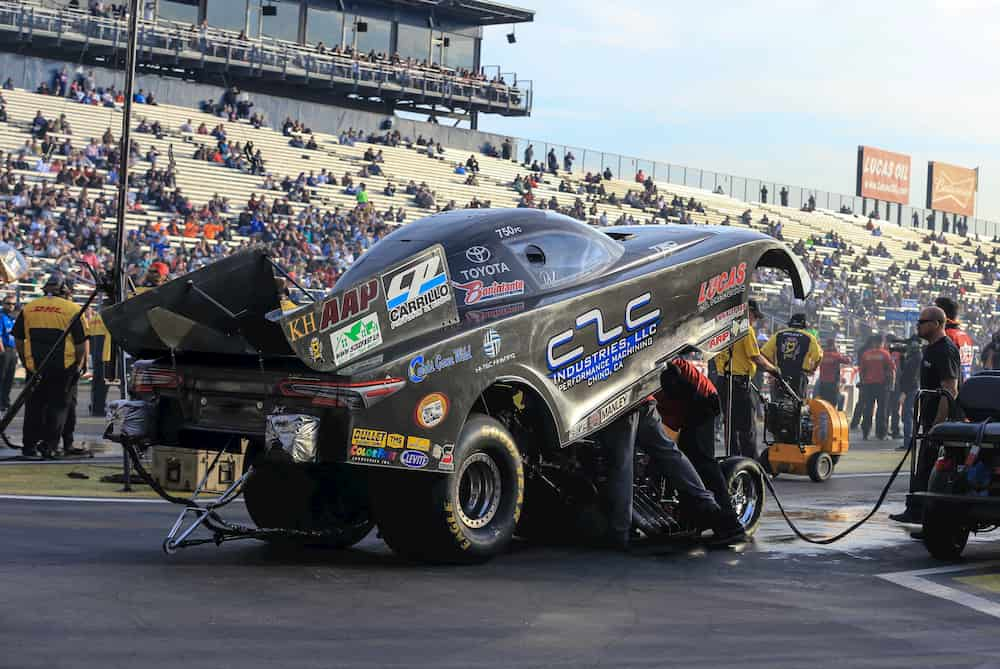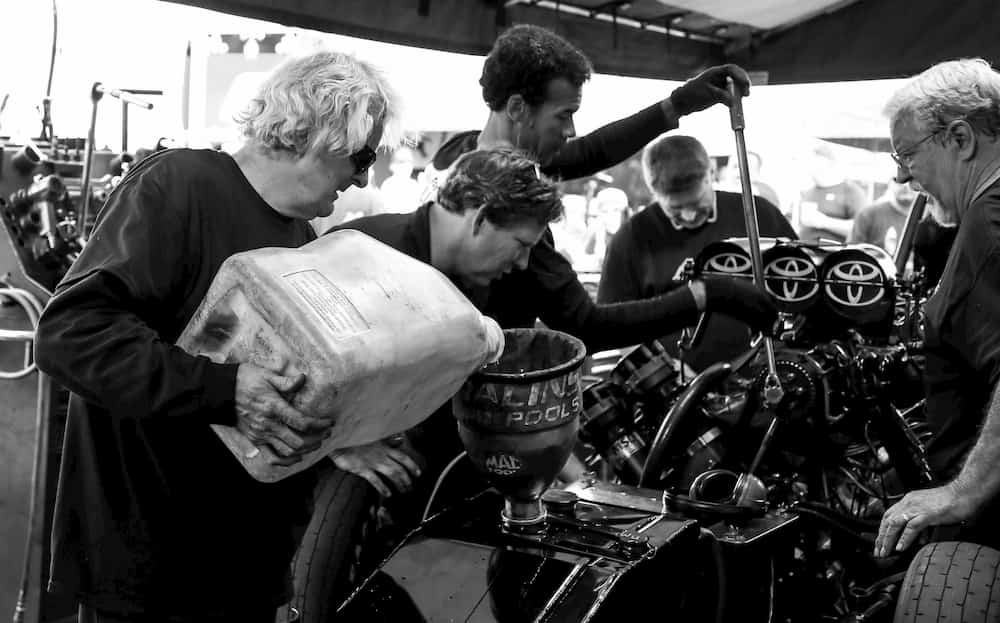Why Funny Cars are called like that? Is that because of the way they open up to induce inside them? It is hard to tell why it is called like that, nobody knows the precise origin or who coined the phrase Funny Car.
Back in the 60s when guys were running the huge superstock factory cars on the drag strip they decided, as racers naturally do, to succeed with larger engines and more horsepower. They ended up with a blown, fuel-injected engine. The funny car developed outside the framework of organized racing. They were late-model muscle cars. These funny cars weren’t integrated into the NHRA until about 1969. Everybody was hesitant about them back then, but they were really popular. The first Funny Cars were Hemi Dodges from the 60s. They’d had the rear wheels moved up the shaft chassis. The rear tires were increased, and greatly oversized from stock. And searching at the cars they looked near stock, but not the simplest.
Hence the name Funny Cars. The name just reasonably stuck and they’re sometimes called floppers; due to the way they flop along. The body shakes quite a bit as they get going. There was talk as recently because the first 90’s about changing the name to ‘fuel coupe’, but that never caught fire. They’re funny cars, although they do not look funny anymore, that’s what they’re which is what they are going to be.

Around the early sixties, Super Stock was one of the popular classes in drag racing. Spectators loved them because of the heavy brand identification since they were stock-bodied cars.
The Super Stock Plymouth, Ford, Chevy or Dodge that you just simply run at the drag strip on Sunday that lifted the front wheels at the green light or flag in the early days. They were loud and fast and looked just like the daily car you drive to work and back. Underneath is not the angel, it is a highly modified devil with strict rules. Rather more so than the ‘stock’ classes, which were allowed little modification from the primary production car and were, in fact, street drivable.
But on balance, drag racers always want to travel faster and quicker. If you took an excellent Super Stock car and modified it an excessive amount, you had to manoeuvre up to the ‘Altered’ class or ‘Gas’ class where a stock bodied.
American car was at an obstacle due to wheelbase length and weight. You had to run against smaller lightweight cars with more latitude in engine modifications and thus, more power.
So, a replacement class was created, called /FX (factory experimental) and most ran A/FX. During this class, they moved the front suspension forward some inches, moved the rear axle ahead, sometimes over a foot, and set the engine back several inches. This allowed for better weight transfer to the rear axle for better traction and was allowed to run lightweight fibreglass hoods and fenders and ‘strip’ inside the interior for added weight savings. They still looked ‘sort of’ stock but with the altered wheel position, they looked ‘funny’ to a spectator. Not funny in an exceedingly way, but funny as in ‘odd’, which they were faster, quicker and louder than Super Stocks.
At first, they were allowed to run an amazing fuel injection system and gasoline, then methanol and fuel injection system, then superchargers and ‘fuel’, a mixture of alcohol and nitromethane. Then it had a tube chassis and one-piece fibreglass bodies. The slang term for them now among racers and spectators alike was ‘floppers’ because the whole body was hinged at the rear and so the nose was raised for the driving force to urge into the car and for access to the engine, then the body was ‘flopped down’ and fastened when the car was able to run.
Then ‘funny cars’ became Fuel Dragsters with a rather shorter wheelbase and full bodies. It only took two or three seasons for the initial A/FX cars to evolve into the primary funny cars, so into what you see today.
Guidelines for Funny Cars
The NHRA has strict guidelines for Funny Cars. Most of the principles relate to the engine. In short, the engines can only be V8s displacing no over 500 cubic inches or 8,193.53cc. Engine’s preferred design is a Donovan, loosely supported on the second-generation Chrysler 426 Hemi.
There can only be two valves per cylinder. The heads are machined from aluminium billet and don’t have water jackets, because the high heat of the methanol within the fuel added to the brevity of the run precludes the wants. Superchargers are restricted to a basic Roots 19-inch rotor case width with a breadth of 11.25. The rotors aren’t allowed to have quite a certain quantity of helical twist in them so that the blower doesn’t become a screw-type supercharger in function. Only single camshafts are allowed. There are two common bore-stroke combinations: 4.1875 in × 4.50 within the 3/4 stroker is the most common combination used today. Crankshafts are CNC machines carved from steel billet and then nitride in an oven to increase surface hardness. Intake valves are titanium and 61 mm in diameter, while exhaust valves are 48 mm in diameter, made of Inconel. Every Funny Car has ballistic blankets covering the supercharger because this part of the engine is susceptible to explosion.

Fuel systems are key to Funny Cars’ immense power. During one-run starting, burnout, backing up, and staging, 1/4 mile cars can burn the max amount as US gallons. The fuel mixture is often 85–90% nitromethane and 10–15% methanol. The ratio of fuel to air is as high as 1:1. Compression ratios vary from 6:1 to 7:1. The engines commonly exhibit varying piston heights and ratios that are determined by the piston’s proximity to the air intake. Dragsters have a set gear ratio of 3.20:1 and have a reversing gear; power is transmitted from the engine to the final drive through a multiple-staged clutch which provides progressive incremental lockup as the run proceeds. The speed and degree of lockup are mechanically/pneumatically controlled and present before each run in step with various conditions, particularly on the track surface. Wheelbases are between 2,500 and 3,200 mm. The car must maintain a 76 mm ground clearance.
Horsepower claims vary from 6,978 to 8,897 but are usually around 8,000 HP. Supercharged, nitromethane fuelled motors of this kind even include a high torque, which is estimated at 9,500 NM. They achieve a 6G acceleration from a standing start, which is very impressive.
How fast are Funny Cars?
Similar to their Top Fuel counterparts but with a shorter wheelbase and a carbon-fibre body that loosely resembles a production-based automobile, Funny Cars can run in a 3.8-sec range and are capable of speeds in excess of 330 mph. These super dragsters transmit all the power to the massive rear slicks through a multistage clutch assembly that is activated by timers.
Most NHRA Funny Car wins
John Force has 151 wins. American NHRA drag racer from California. Force has a vast collection of awards and he is well known 16-time NHRA and 1-time AHRA Funny Car champion. Force owns and drives for John Force Racing and he is a 21-time champion car owner.
Ron Capps has 65 wins. Ron’s hometown is San Luis Obispo, Calif. He marked his career by winning twenty NHRA Funny Car national events.
Robert Hight has 51 wins. Robert Hight is an NHRA drag racer and president of John Force Racing. He also is a driver of the Auto Club of Southern California Chevrolet Camaro SS Funny Car.
NHRA Funny Car champion 2022
2022 – Ron Capps wins NHRA Funny Car Championship
Ron Capps was watching the race near the racing track between Alexis DeJoria’s Del Worsham and 2020 champion Matt Hagan. This time Ron should say thanks to Alexis for winning against Hagan and for helping him to win the second NHRA Funny Car Championship.





